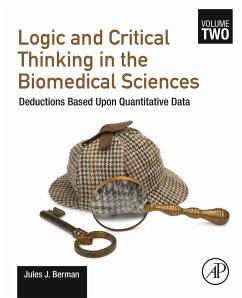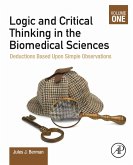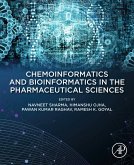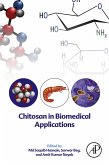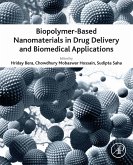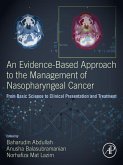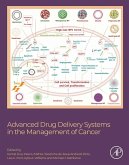Logic and Critical Thinking in the Biomedical Sciences (eBook, ePUB)
Volume 2: Deductions Based Upon Quantitative Data


Alle Infos zum eBook verschenken

Logic and Critical Thinking in the Biomedical Sciences (eBook, ePUB)
Volume 2: Deductions Based Upon Quantitative Data
- Format: ePub
- Merkliste
- Auf die Merkliste
- Bewerten Bewerten
- Teilen
- Produkt teilen
- Produkterinnerung
- Produkterinnerung

Hier können Sie sich einloggen

Bitte loggen Sie sich zunächst in Ihr Kundenkonto ein oder registrieren Sie sich bei bücher.de, um das eBook-Abo tolino select nutzen zu können.
All too often, individuals engaged in the biomedical sciences assume that numeric data must be left to the proper authorities (e.g., statisticians and data analysts) who are trained to apply sophisticated mathematical algorithms to sets of data. This is a terrible mistake. Individuals with keen observational skills, regardless of their mathematical training, are in the best position to draw correct inferences from their own data and to guide the subsequent implementation of robust, mathematical analyses. Volume 2 of Logic and Critical Thinking in the Biomedical Sciences provides readers with a…mehr
- Geräte: eReader
- mit Kopierschutz
- eBook Hilfe
- Größe: 25.79MB
![Logic and Critical Thinking in the Biomedical Sciences (eBook, ePUB) Logic and Critical Thinking in the Biomedical Sciences (eBook, ePUB)]() Jules J. BermanLogic and Critical Thinking in the Biomedical Sciences (eBook, ePUB)80,95 €
Jules J. BermanLogic and Critical Thinking in the Biomedical Sciences (eBook, ePUB)80,95 €![Chemoinformatics and Bioinformatics in the Pharmaceutical Sciences (eBook, ePUB) Chemoinformatics and Bioinformatics in the Pharmaceutical Sciences (eBook, ePUB)]() Chemoinformatics and Bioinformatics in the Pharmaceutical Sciences (eBook, ePUB)96,95 €
Chemoinformatics and Bioinformatics in the Pharmaceutical Sciences (eBook, ePUB)96,95 €![Biomedical Innovations to Combat COVID-19 (eBook, ePUB) Biomedical Innovations to Combat COVID-19 (eBook, ePUB)]() Biomedical Innovations to Combat COVID-19 (eBook, ePUB)106,95 €
Biomedical Innovations to Combat COVID-19 (eBook, ePUB)106,95 €![Chitosan in Biomedical Applications (eBook, ePUB) Chitosan in Biomedical Applications (eBook, ePUB)]() Chitosan in Biomedical Applications (eBook, ePUB)128,95 €
Chitosan in Biomedical Applications (eBook, ePUB)128,95 €![Biopolymer-Based Nanomaterials in Drug Delivery and Biomedical Applications (eBook, ePUB) Biopolymer-Based Nanomaterials in Drug Delivery and Biomedical Applications (eBook, ePUB)]() Biopolymer-Based Nanomaterials in Drug Delivery and Biomedical Applications (eBook, ePUB)128,95 €
Biopolymer-Based Nanomaterials in Drug Delivery and Biomedical Applications (eBook, ePUB)128,95 €![An Evidence-Based Approach to the Management of Nasopharyngeal Cancer (eBook, ePUB) An Evidence-Based Approach to the Management of Nasopharyngeal Cancer (eBook, ePUB)]() An Evidence-Based Approach to the Management of Nasopharyngeal Cancer (eBook, ePUB)114,95 €
An Evidence-Based Approach to the Management of Nasopharyngeal Cancer (eBook, ePUB)114,95 €![Advanced Drug Delivery Systems in the Management of Cancer (eBook, ePUB) Advanced Drug Delivery Systems in the Management of Cancer (eBook, ePUB)]() Advanced Drug Delivery Systems in the Management of Cancer (eBook, ePUB)128,95 €
Advanced Drug Delivery Systems in the Management of Cancer (eBook, ePUB)128,95 €-
-
-
Volumes 1 and 2 of Logic and Critical Thinking in the Biomedical Sciences are written for biomedical scientists and college-level students engaged in any of the life sciences, including bioinformatics and related data sciences.
- Demonstrates that a great deal can be deduced from quantitative data, without applying any statistical or mathematical analyses
- Provides readers with simple techniques for quickly reviewing and finding important relationships hidden within large and complex sets of data
- Using examples drawn from the biomedical literature, discusses common pitfalls in data interpretation and how they can be avoided
Dieser Download kann aus rechtlichen Gründen nur mit Rechnungsadresse in A, B, BG, CY, CZ, D, DK, EW, E, FIN, F, GR, HR, H, IRL, I, LT, L, LR, M, NL, PL, P, R, S, SLO, SK ausgeliefert werden.
- Produktdetails
- Verlag: Elsevier Science & Techn.
- Seitenzahl: 290
- Erscheinungstermin: 8. Juli 2020
- Englisch
- ISBN-13: 9780128213629
- Artikelnr.: 61689440
- Verlag: Elsevier Science & Techn.
- Seitenzahl: 290
- Erscheinungstermin: 8. Juli 2020
- Englisch
- ISBN-13: 9780128213629
- Artikelnr.: 61689440
-Taxonomic Guide to Infectious Diseases: Understanding the Biologic Classes of Pathogenic Organisms, 1st edition (2012) -Principles of Big Data: Preparing, Sharing, and Analyzing Complex Information (2013) -Rare Diseases and Orphan Drugs: Keys to Understanding and Treating the Common Diseases (2014) -Repurposing Legacy Data: Innovative Case Studies (2015) -Data Simplification: Taming Information with Open Source Tools (2016) -Precision Medicine and the Reinvention of Human Disease (2018) -Principles and Practice of Big Data: Preparing, Sharing, and Analyzing Complex Information, Second Edition (2018) -Taxonomic Guide to Infectious Diseases: Understanding the Biologic Classes of Pathogenic Organisms, 2nd edition (2019)
